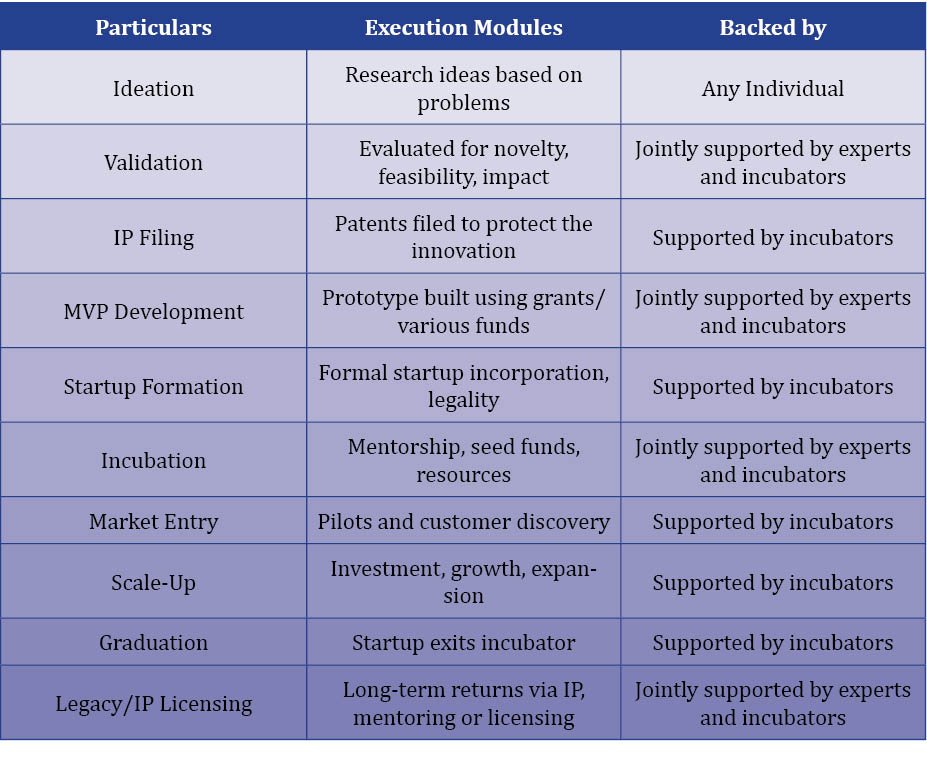As the global security landscape undergoes tectonic shifts from traditional state threats to hybrid warfare, cyber incursions, and AI-enabled disinformation, the importance of self-reliance in defence technologies has never been more urgent. For a nation like India, with its strategic ambitions and complex threat environment, strengthening national security is no longer just about increasing military expenditure or acquiring platforms; it is about fostering a dynamic, innovative ecosystem, especially within its universities and research institutions.
This article addresses the pressing need to cultivate an incubation culture within universities as a core component of that innovation ecosystem. By promoting start-ups, supporting deep-tech research, and facilitating industry-academia collaborations through dedicated incubation centres, Indian universities can play a pivotal role in developing indigenous defence technologies and dual-use innovations that enhance both national security and economic resilience.
The Changing Face of Warfare and Security
National security today extends far beyond borders and battlefields. It encompasses cyberspace, outer space, biotechnology, unmanned systems, quantum computing, and advanced materials. There are compelling examples in the world that reflect the importance of startup-driven defence innovation centres. Israel’s Directorate of Defence R&D (MAFAT) focuses on startup-driven defence innovation, and the US Defence Advanced Research Projects Agency (DARPA)-led ecosystem offers compelling examples of how technology is the weapon of deterrence. Russia’s Foundation for Advanced Research Projects (FPI) emphasise strategic deterrence and information warfare. China’s Chinese Academy of Military Sciences (CAMS) & CETC focus on rapid military modernisation with state-driven innovation aimed at peer-level parity with high technology. Japan’s ATLA (Acquisition, Technology & Logistics Agency) merges traditional pacifist defence with cutting-edge R&D for homeland security and strategic deterrence.
Against this backdrop, India’s traditional dependence on imports is increasingly becoming a strategic vulnerability. The future of India’s defence readiness lies not just in big-ticket procurement, but in the capacity to innovate, indigenise, and scale technologies that are tailored to India’s operational terrain and threat matrix.
To achieve this, universities can play a pivotal role in this transformation by acting as incubators of defence innovation. Through dedicated research parks, technology transfer offices, and collaboration with defence public sector undertakings (DPSUs) and the private sector, universities can bridge the gap between academic research and deployable technologies. By nurturing interdisciplinary programmes in defence technology, AI, Cybersecurity, Aerospace, and materials science, academic institutions can provide the intellectual and infrastructural backbone necessary to drive indigenous innovation. Empowering students and faculty to engage in mission-driven R&D will not only contribute to strategic self-reliance but also cultivate a generation of technocrats deeply aligned with national security imperatives.
Universities: The Untapped Arsenal
As per the All-India Survey of Higher Education by the Department of Higher Education, there are 1,339 universities in India. Out of them, 54 are Central universities and 965 are State Public and Private Universities. There are a total of 158 Institutes of National Importance, six Institutes under the State Legislature Act and 241 R&D Institutes, with several emerging as centres of excellence in artificial intelligence, cybersecurity, electronics, quantum mechanics, aerospace, and material sciences. These institutions, when integrated with the national security apparatus through their powerful incubators, followed by structured innovation programmes and their tech resources (professors and startups), can act as niche, disruptive technology integration for national security.
Moreover, universities possess three unique assets vital to a national security innovation ecosystem:
- Young Talent Pool: With over 40 million students, India’s higher education sector houses the largest youth cohort capable of ideating, experimenting, and engineering future warfare solutions.
- Multidisciplinary Expertise: Security challenges are not merely technological but also social, legal, and psychological. Universities foster cross-domain research that can shape policy, ethical frameworks, and use-case adaptation.
- Research Infrastructure: Many premier institutions, including IITs, IISc, NITs, DRDO-supported labs, and even private universities, are already conducting cutting-edge research that, with direction, can be militarised or dual-purposed.
The Startup Ecosystem as a Strategic Lever
India is now the third-largest startup ecosystem globally. In the defence space, however, only a handful of startups have broken through the procurement ceiling. This needs to change. Startups are agile, hungry for disruption, and unencumbered by bureaucratic inertia. With the right mentorship, capital, and use-case alignment, startups can act as R&D accelerators for national defence.
India’s iDEX (Innovations for Defence Excellence) platform is a step in the right direction. However, greater synergy with university and incubator ecosystems is essential to ensure a bottom-up, indigenous defence innovation pipeline. Moreover, Atal Incubation Centres implemented by Atal Innovation Mission are key game changers in the ecosystem. Most of the AICs established are sector-specific in areas such as manufacturing, defence, transport, energy, health, education, agriculture, water, sanitation, Internet of Things, and cybersecurity, to promote unprecedented technological innovation in these sectors.
University-based incubators already demonstrate how academia, startups, and the armed forces can co-create niche solutions, from swarm drones and anti-drone systems to wearable soldier tech and smart surveillance algorithms.
Why We Need a Structured University-Defence Innovation Framework
To fully harness the potential of universities and startups for national security, India needs a systemic policy architecture that includes:
- Defence Innovation Fellowships: A focused programme to embed graduates, post-graduates and PhD researchers within DRDO, military units, or defence manufacturing hubs to solve real-time operational problems.
- Mission-Mode Challenges: The Ministries of Home Affairs, Defence and External Affairs can release challenge statements separately to universities, incubators for time-bound R&D with a minimum order value procurement system.
- Testbeds and Sandboxes: Providing access to simulated environments or retired military platforms for testing student and startup technologies in realistic conditions.
- Dual-Use Technology Pipelines: Encouraging academic innovations that serve both civilian and military use, like disaster response drones, encrypted messaging platforms, or bio-sensors.
- IP Protection and Procurement Access: Legal frameworks and fast-track procurement policies that allow startups to retain IP and get early adoption within the armed forces.
The University-Incubator ecosystem should follow the ‘Womb to Tomb’ or ‘Inception to Acquisition/IPO’ lifecycle of incubation.

Real-World Impact: Case Studies
While policy frameworks and incubation models offer a promising blueprint, the true measure of success lies in the tangible outcomes of real startups solving real defence problems. Across India, a handful of pioneering ventures nurtured by incubators, supported by iDEX, and aligned with national security needs have begun to demonstrate how academic ecosystems can fuel strategic innovation. These cases not only validate the model but also underscore the transformative potential of linking universities and startups to the defence architecture. Some of them are:
- Arishti Info Labs, an Indian cybersecurity company pioneering OT and ICS security for critical infrastructure. With a mission to safeguard industrial operations from cyber threats, Arishti delivers agentless, passive, and intelligent monitoring through its flagship product, Dorje – a SaaS-based platform built for real-time asset visibility, threat detection, and vulnerability assessment.
Dorje secures manufacturing, energy, and utility networks by passively analysing industrial traffic, detecting anomalies through behaviour-based models, and identifying risks in SCADA, PLCs, and protocols like Modbus, PROFINET, and OPC UA. It enables network segmentation, early threat alerts, and live dashboards, all without disrupting plant operations.
National Security Impact: Arishti Info Labs plays a key role in protecting India’s critical infrastructure, including power grids, water systems, and industrial supply chains from cyberattacks. Dorje’s deployments have exposed threats like malware, outdated firmware, and rogue access attempts, preventing potential disasters. Its indigenous design supports government-led initiatives such as Make in India and Startup India, contributing directly to India’s cyber sovereignty and resilience. Collaborations with key sectors demonstrate how Dorje enhances cyber preparedness against foreign and state-sponsored attacks, reinforcing national security through proactive, scalable industrial surveillance and defence.
Arishti is not just a cybersecurity company; it’s a strategic partner in India’s cyber defence framework for Industry 4.0.
- Swadeshi Empresa Pvt Ltd started as any other fire-fighting equipment manufacturing company. But with the vision to revolutionise fire safety, the company soon branched into the development of unmanned vehicles that could be remotely deployed for firefighting. This would ensure the safety of firefighting teams while facing the most challenging fire accidents. With support from IDEX and DIO, Swadeshi developed a one-of-a-kind firefighting robot that has been successfully deployed at naval bases along the coastline of India. The product has also been well received and appreciated by civil fire services, the power sector, and the oil and gas industries in India and abroad.
National Security Impact: The firefighting robot is key to the safety of ships, armament depots, dockyards and other establishments of the Indian Navy. They minimise the risk to the lives of NBCD teams (Nuclear, Biological, Chemical Defence and Damage Control) while giving them a capable platform for efficient firefighting.
- Tonbo Imaging is at the forefront of India’s defence innovation with its indigenous Wave Strike, the country’s first deployable Gen-3 High-Power Microwave (HPM) system. HPM represents a non-kinetic, electromagnetic defence capability designed to disable the electronics of hostile systems, making it highly effective against autonomous drone swarms, AI-powered platforms, and electronic warfare threats.
Unlike conventional systems relying on RF jamming or GPS spoofing, Wave Strike neutralises core electronics, rendering even fully autonomous, communication-independent drones inoperable. It is a future-proof solution, critical in a battlefield dominated by smart and self-guided systems.
Strategically positioned as the first line of defence, HPM prevents saturation of kinetic air defence systems, enabling better resource utilisation. Key advantages include multi-target neutralisation, deep magazine capability (requiring only power), collateral-free engagement, and deployment versatility across land, sea, and air platforms.
National Security Impact: Wave Strike boosts India’s self-reliance in advanced defence tech under the Make in India initiative and significantly strengthens the national security architecture. By providing early threat interception and superior electronic warfare capabilities, HPM systems like Wave Strike are not just defensive assets but strategic force multipliers essential for securing India’s critical infrastructure and military superiority in modern warfare.
Conclusion: A Call to Action
National security in the 21st century is no longer defined by the size of an army or the stockpile of conventional weapons; it is defined by a nation’s ability to innovate, adapt, and lead in disruptive technologies. It is a tech-first, knowledge-driven enterprise where agility, intelligence, and foresight determine strategic superiority. India, with its vast talent pool, thriving academic institutions, and burgeoning startup ecosystem, stands at a historic inflection point.
We can no longer afford to let our intellectual capital remain siloed from our security imperatives. The real power lies in connecting our universities with the mission of national defence, turning laboratories into launchpads, classrooms into command centres of ideation, and incubation hubs into engines of strategic deterrence.
By mainstreaming university-based startups and research into our national security strategy, India not only moves closer to achieving Aatmanirbharta (self-reliance) but also positions itself as a global hub of strategic innovation, a knowledge superpower capable of safeguarding its sovereignty while shaping the future of security technology worldwide. The time has come to convert India’s ‘brainpower surplus’ into ‘security power’. Our universities and incubators should not remain ivory towers, but act as India’s new defence frontiers.







